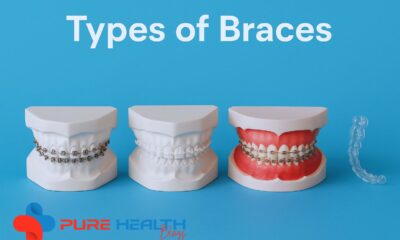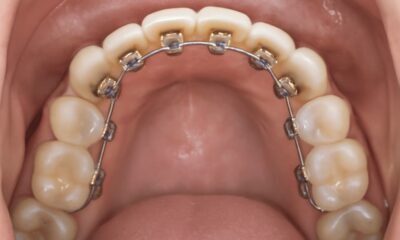General Health & Wellness
How Long Does It Take to Fill a Cavity? A Complete Guide

Cavity fillings are among the most common dental procedures, but many people still wonder, “How long does it take to fill a cavity?” Whether the cavity is on a front tooth, a molar, or involves lingual braces or ceramic braces, the procedure time can vary. In this guide, we break down how long does It take to fill a cavity? and total time required for filling different types of cavities, what factors influence the procedure, and how braces play a role in the process.
The duration taken to fill a tooth cavity takes more than the size of the cavity itself, according to Dr. Emily Stevens of Smile Care Dentistry, it varies depending on the material and the location of the tooth cavity. A front tooth especially a patient with braces must be done with an additional perfection so that the end outcome is not only practical but equally beautiful.”

What is a Cavity and Why Does It Need to Be Filled?
A cavity is a defected portion within a tooth due to decay. Over time, bacteria in the mouth feed on sugars, forming acids that eat away at the enamel. If untreated, a cavity can progress, leading to tooth sensitivity, pain, and eventually tooth loss. A cavity on a front tooth, for instance, can not only cause pain but also impact your smile, making it even more important to fill it properly and promptly.
Filling a cavity restores the affected tooth by filling in the decayed area, preventing further damage. The filling material seals the tooth and helps prevent bacteria from entering, thus protecting the tooth and maintaining its function.
Expert Opinion:
According to Dr. John Matthews, a certified dentist at Bright Smile Dental Care, it is important to fill the cavity in time that will maintain not only the health of your teeth but also its appearance. The untreated cavities do not only hurt but may result in worse issues such as root canal or tooth removal.
How Long Does It Take to Fill a Cavity?
The process of filling a cavity can be completed within a short period of time, and the time taken is dependent on many variables such as the size and the position of the cavity among other factors as well as the type of the filling substance employed. A cavity filling takes in average 20 minutes to one hour. It may, however, take much longer, particularly when the cavity is located on a front tooth or when the person has braces.
Expert Opinion:
Dr. Lydia Chan, a dentist with more than 15 years of experience, says that such a procedure can take a little longer when done on a front tooth where front aesthetics is a major consideration and, in such cases, it is common to use composite or ceramic fillings. They require more time to shape and harden than the conventional fillings and they offer a natural tooth-like look.”
Factors Affecting the Time to Fill a Cavity
Size of the Cavity
Among the main factors that define the length of time in the procedure is the size of the cavity. In case the cavity is not taking a lot of space within the tooth and is small, the operation is much quicker and can take an average of 30-20 mins. However, the larger ones, particularly the ones that hit the root area or the inner areas of the tooth, require more time of cleansing decay, filling the hole and sufficient time to the materials utilized to harden appropriately.
Expert Opinion:
According to a well-known endodontist Dr. Steven Roberts says that small holes on the back teeth or molar can be filled within a short time. There are however, those cavity which have gone even deeper into the tooth or the root of the tooth and the filling of the cavity requires a lot of time. The dentist should make sure that there is no leftover decay and this might involve the need to do deeper cleaning.
Type of Filling Material Used
The filling material also plays a role on the duration of the procedure performed. As an example, the amalgam fillings are robust and visible, and it does not take much time to be installed. Conversely, dentists majorly apply composite resin and ceramic fillings in the aesthetic scope specifically in the front teeth hence saving time in work outs. They should be perfectly shaped that they can fit in and with the ceramic fillings there would normally be the use of special fittings to enable them to fit perfectly.
Expert Opinion:
Location of the Cavity
The procedure time is also dependent on the location of the cavity. As another example, a hole on a back tooth can prove to be simpler to fill compared to a hole in a front tooth especially when you are wearing braces. When it comes to repairing a cavity on a front tooth, one should be more careful because it should be aesthetic and functional. The position of the cavity may also make it harder to reach the tooth particularly to individuals with ceramic braces and lingual braces that may limit the dentist capacity to reach the problem area comfortably.
Expert Opinion:
Dr. Maria Thompson, a dental care provider at Harmony Dental Clinic, adds, in the case of person with lingual braces, filling of a cavity in the back teeth becomes easy as opposed to the front teeth where precision and aesthetics are also major factors to be considered. This takes the dentist more time and attention so as to ensure that the filling occupies the right position and does not interfere with the braces.”
The Procedure for Filling a Cavity
filling a cavity process an examination of the mouth, cleaning a cavity and the filling of a cavity usually consist of about three main steps. What about all these stages? Let us look at each of them.
Step 1 – Examination and Numbing
The first stage of cavity filling procedure involves examination of that tooth to determine the size and the depth of the cavity. Among one of the equipment that the dentist may use during this preliminary check-up is using the X-rays to identify the depth of the decay in order to set the extent of it. Then, the dentist applies local anesthetics near the cavity. This anesthetic will make you develop some numbness so that during this operation, you do not feel any form of pain, especially where the cavity is on the front tooth or close to the sensitive parts.
With the lingual or ceramic brace users, the dentist will take his/her time to burn the area to ensure that he does not stimulate the braces and also reassure the patient, the fact that he/she will not be in discomfort.
Expert Opinion:
Dr. Eric Franklin states that undergoing a dental operation may cause mild fear in most people, but since it is local anesthesia, it is possible to control this and endure the pain, a dentist that focuses on cosmetic dentistry. In the case of patients who wear braces, it is crucial to numb the area not to make them feel uncomfortable during the process.
Step 2 – Cleaning the Cavity
The dentist starts working on the affected side of a tooth with special dental tools after anesthetizing the area. The dentist takes out the decayed part and cleans the surface of the bacterium. This is essential in the pre-loading process in that it will enable the filling to apply to the tooth correctly, so as this will avert decay in the future.
In the case of the front teeth cavity, aesthetics is of primary concern, so the dentist will need to be extra attentive in order not to hurt the enamel or other teeth nearby. There may be a slight difficulty in crushing with lingual braces, as in that case, the dentist also has to clean behind the braces which are tightly bonded around the teeth.
Step 3 – Filling the Cavity
After cleaning of the cavity the dentist will then fill the tooth with selected type of filling material. In the case of teeth such as the front ones, a composite resin or ceramic filling is usually used because they are practically invisible and cannot be distinguished with the color of the teeth. The dentist will precisely place layers and manufacture the material into the size of the cavity and shape. This may be time consuming particularly when a high degree of accuracy is to be attained in aesthetic restoration.
In case with lingual braces, one should somehow be extra careful when applying the design of filling so that the person can avoid damaging the braces. The dentist might have to employ special equipment’s or methods to ensure that the filling work does not conflict with teeth alignment.
How Long Does It Take to Fill a Cavity on a Front Tooth?
The procedure of filling a cavity that is on a front tooth is a bit slower than that done on any other tooth due to the consideration of looks. Whenever you speak or smile out, front teeth come out hence it is obligatory that whatever filling is applied shall coincide well with your tooth.
Expert Opinion:
“Dr. Sophia Harris, a dentist specializing in cosmetic dentistry, claims that on the front tooth it is important to fill the cavity with a greater precision. Such cases we use composite resin or ceramic filling since it is customizable to the natural color of the tooth. This is more time-consuming but gives much more satisfying effect as the result appears as natural and fits the rest of the teeth.”
Lingual Braces and Their Impact on Filling Cavities
Lingual braces are installed at the back of the teeth which makes them less visible compared to the traditional ones. Nevertheless, these braces cause cavity filling to be more difficult since there is little accessibility to the teeth.
How Lingual Braces Affect the Procedure
The dentist needs to take extra special care not to disturb the braces when filling a cavity to the person who has lingual braces. The process may be a little bit longer since the dentist will be operating around the braces so as not to injure it. To achieve this, the dentist has to take the right positioning and be precise so as to fill the gap sufficiently without interfering with the braces and the teeth pattern.
Expert Opinion:
Dr. Laura Mitchell, an orthodontist, who works with lingual braces, says, “Even the process of filling cavities takes more time when one is wearing lingual braces. The dentist should be extra keen that he fixes the cavities in the right position and that these cavities should not interfere with the braces that have been fixed to the back side of the teeth.
Ceramic Braces and Their Impact on Filling Cavities
Filling a cavity in a tooth wearing ceramic braces may be slightly less tricky than the lingual braces, as the braces are on the visible side of the teeth and are easier to reach. Nevertheless, the dentist must remain careful not to break the wires or the brackets. Aesthetic properties of composite resins or ceramic fillings make them the main favorites among the possibilities to fill the cavities in the front teeth of ceramic braces patients.
Impact on Filling Cavities with Ceramic Braces
About filling the cavity on the tooth using ceramic braces- this process can be somewhat simpler than the put off braces as braces are on the front side as opposed to lingual side which is more inaccessible. Nonetheless, the dentist must remember to do it carefully in order to not break the brackets or entangle the wires. Aesthetic properties of composite resins or ceramic filling tend to be favorite options with front teeth cavities where the patient has ceramic braces.
Conclusion
The procedure of cavity filling depends on many factors, such as the magnitude of the cavity, the position of the tooth and even in the case of the patient wearing braces. The front tooth cavities, or the cavities on individuals in lingual/ ceramic braces may be slow because of their aesthetic and technical reasons. But a procedure normally involves 20 minutes to an hour.
Expert Opinion:
According to Dr. Thomas Bailey, one of the best dentists in cosmetic restoration, starting treatment against cavities early is the only way to a good oral health whether you are wearing braces or not. In case of the front teeth cavities, it is particularly necessary that you choose a dentist, who has experience in aesthetic fillings, in order to make the outcome look natural.”
The only way a cavity filling can turn out to be successful and that the procedures will be efficient is by informing your dentist on the most efficient materials in relation to your needs and condition of your mouth. Other complications can be avoided through regular check ups and immediate corrective measures to cure the cavities so as to ensure that you keep smiling.
Frequently Ask Questions About How Long Does It Take to Fill a Cavity
1. How long does it take to fill a cavity?
The duration used to fill a cavity is normally 20 minutes to one hour. The length is dependent on factors including size of the cavity, where it is located, and the kind of material employed. The time is longer when it is large cavities or cavities on front teeth since this has a cosmetic issue.
2. Can cavities on front teeth be filled the same way as those on back teeth?
The cavity on front teeth needs to have a more cosmetic mean, so it can be filled by composite resin or ceramic fillings in order to match the composition of the natural tooth. Back teeth can be amalgam or more lasting substances, and this can be less time-consuming to receive.
3. What is the best filling material for front teeth?
In the case of front tooth, most widely used material is composite resin and ceramic fillings as those best fit the natural color of the tooth. These materials have been selected due to their esthetic properties and are able to better give a more realistic restoration.
4. How long does a cavity filling last?
Each cavity filling has a certain lifespan which varies depending on the material used. Amalgam fillings can last up to 10-15 years of use and composite fillings are estimated at 5-7 years. The duration of the life of the filled tooth may depend on the conditions of oral hygiene, food, and the position of the teeth.
5. Will getting a cavity filled hurt?
Fillings of cavities on the teeth do not cause serious pain, since the dentist will administer local anesthetic to the affected mouth region. Most of the time there is minimum pain, except that you may be feeling a bit pressurized during the procedure. In case you are worried about discomfort, please share the feelings with your dentist prior to the operation.
6. Can I eat after getting a cavity filled?
Once you have a composite filling or ceramic filling, it is advisable that you do not eat at least 30 minutes or maybe an hour so that the material can set well. In the case of amalgam fillings, usually it is recommended that 24 hours must be allowed prior to consumption of hard and sticky food.
7. How does having braces affect the cavity filling process?
The presence of lingual braces or ceramic braces can complicate the process of filling the cavity as they do not make reaching the teeth easy. During the procedure the dentist has to be very careful not to break the braces hat may increase the time taken to fill up the filling by a slight margin.
8. Can I get a cavity filled while wearing braces?
Yes, it is possible to fill cavities with lingual braces or ceramic braces, only it may take more time. The dentist will go around the braces using caution such that the filling will not interfere with where the teeth will go or damage the braces.

 General Health & Wellness1 month ago
General Health & Wellness1 month agoStartling Facts: Can Stress Cause Hemorrhoids? Know It All

 Men & Women's Health4 weeks ago
Men & Women's Health4 weeks agoLatest Types of Braces: Unexpected Costs, Benefits & Best Treatments

 Mental Health3 weeks ago
Mental Health3 weeks agoThe Silent Panic Attack Trap That’s Hurting Millions Now

 Diet & Nutrition2 months ago
Diet & Nutrition2 months agoRare Lemon Balm Benefits That Will Calm Your Mind & Heart

 Diet & Nutrition2 months ago
Diet & Nutrition2 months agoHow to Make a Lemon Balm Tea for Effective Weight Loss

 Men & Women's Health2 months ago
Men & Women's Health2 months agoComplete Truth About Lingual Braces Costs, Benefits And Care

 Recipes2 months ago
Recipes2 months agoHow to Make Melissa Tea at Home: A Step-by-Step Guide

 General Health & Wellness2 months ago
General Health & Wellness2 months agoIs Your Unusual Heel Pain a Scary Serious Problem?





















































